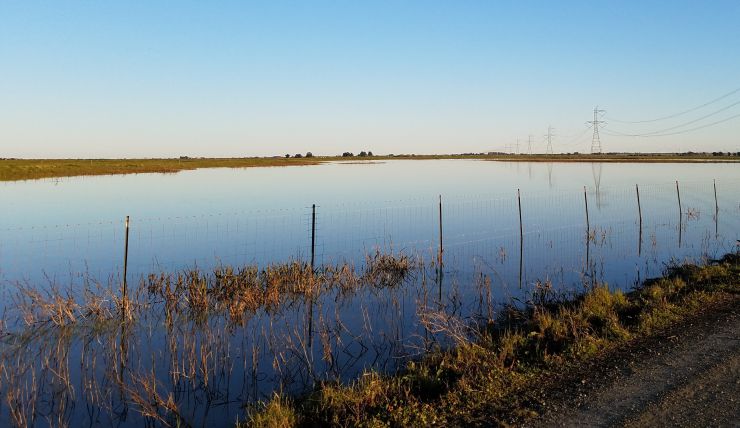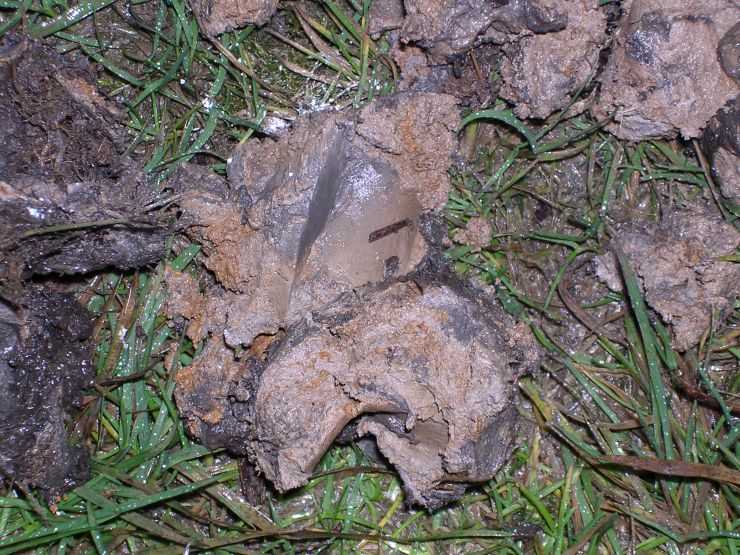Background:
Excessive water and poor drainage may reduce yields for many crops due to a lack of oxygen in the water logged root zone. Such anoxic conditions also promote the reduction and gaseous loss of nitrogen, decreasing nitrogen use efficiency and releasing potent greenhouse gases, threatening soil health.1 Further, excessive water may make accessing fields for planting or harvest challenging.2 Excessive water may also make plants more susceptible to root rot and other disease.3 Dealing with excessive water is a challenge; in areas with excessive, significant physical labor may be necessary to improve drainage or lower the local water table. After lowering the water table, soil oxidation may lead to soil acidification, requiring further management.4

Surface Ponding- Devin
Diagnosis:
Surface ponding of water is a sure sign of poor drainage. Poor drainage may also be identified by the formation of redoximorphic features in soil due to the reductive dissolution of Fe3+ containing minerals and subsequent loss of soluble Fe2+ which leaves soil with a gray appearance, referred to as gleying. Soils which shrink and swell during wetting and drying, have a mottled appearance due to seasonal saturation, or the presence of aquatic plants are other indicators of soils which suffer from excessive water and poor drainage.

https://commons.wikimedia.org/wiki/File:Gley.JPG
By en:User:Jonty68 (http://en.wikipedia.org/wiki/Image:DSCN0387.JPG) [Public domain], via Wikimedia Commons
Management:
Below is a short summary of various management practices. For a full list of additional resources click here.
Improving soil structure
These practices work as they help increase the size and number of large pores in the soil, increasing the rate with which water moves through the soil.
- Increasing soil organic matter can improve soil structure by improving soil aggregation.
- Applying gypsum can also improve soil structure in heavy clay soils.
See section on low organic matter for additional resources.
Engineered controls on water
These practices are extremely labor intensive, but are extremely effective at ameliorating excess water.
- Leveling fields can reduce ponding in low lying areas
- Installing subsurface drainage can reduce local water tables and improve drainage.
- Water furrows can be used to increase the distance between the soil surface and the local water table.
Additional Resources:
Engineered controls on water
A chapter on drainage for citrus in Florida developed by the University of Florida.
https://edis.ifas.ufl.edu/ch165.
A review on new approaches to agricultural land drainage developed by the Pontifica Universidad de Catolica de Chile.
https://www.omicsonline.org/open-access/new-approaches-to-agricultural-land-drainage-a-review-2168-9768-1000135.php?aid=60715
An engineering field handbook chapter developed by the USDA on drainage and soil water management.
https://directives.sc.egov.usda.gov/OpenNonWebContent.aspx?content=17551.wba.
An engineering field handbook chapter developed by the USDA on water table control.
https://directives.sc.egov.usda.gov/OpenNonWebContent.aspx?content=18376.wba.
A book on draining agricultural lands developed by the USDA.
https://directives.sc.egov.usda.gov/OpenNonWebContent.aspx?content=18372.wba.
A web based manual developed by the Agricultural Land Commission of the Government of British Columbia.
https://www2.gov.bc.ca/gov/content/industry/agriculture-seafood/agricultural-land-and-environment/water/drainage/agricultural-drainage-manual
A chapter on identifying soil drainage issues developed by the Agricultural Land Commission of the Government of British Columbia.
https://www2.gov.bc.ca/assets/gov/farming-natural-resources-and-industry/agriculture-and-seafood/agricultural-land-and-environment/water/agricultural-drainage-model/525500-1_drainage_manual_-_web_chapter_04.pdf.
A chapter on soil drainage solutions developed by the Agricultural Land Commission of the Government of British Columbia.
https://www2.gov.bc.ca/assets/gov/farming-natural-resources-and-industry/agriculture-and-seafood/agricultural-land-and-environment/water/agricultural-drainage-model/525500-1_drainage_manual_-_web_chapter_05.pdf.
References:
- Linn, D. M.; Doran, J. W., Effect of water-filled pore space on carbon dioxide and nitrous oxide production in tilled and nontilled soils 1. Soil Science Society of America Journal 1984, 48 (6), 1267-1272.
- Tan, C.; Drury, C.; Gaynor, J.; Welacky, T.; Reynolds, W., Effect of tillage and water table control on evapotranspiration, surface runoff, tile drainage and soil water content under maize on a clay loam soil. Agricultural Water Management 2002, 54 (3), 173-188.
- Kuan, T.; Erwin, D., Predisposition effect of water saturation of soil on Phytophthora root rot of alfalfa. Phytopathology 1980, 70 (10), 981-986.
- Ponnamperuma, F.; Martinez, E.; Loy, T., Influence of redox potential and partial pressure of carbon dioxide on pH values and the suspension effect of flooded soils. Soil Science 1966, 101 (6), 421-431.
